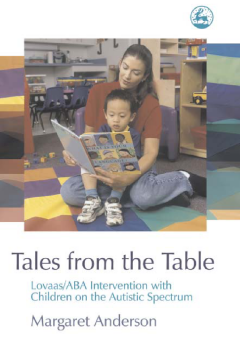
Additional Information
Book Details
Abstract
Tales from the Table is a practitioner's account of the successes and limitations of using Lovaas/ABA home education with five young boys on the autistic spectrum.
The abilities and skills of these children before, during and after intervention are documented with a focus on the realities of undertaking Lovaas/ABA home education: the impact of a 35-hour learning week on both child and parents, changing tutors and issues of commitment to the approach. Each chapter includes a commentary on the programme from a different perspective, with the voices of parents, siblings and teachers providing the context to the individual children's learning processes.
This book will help parents to make an informed decision about using Lovaas/ABA interventions and will give professionals and students practical insights and useful information on the approach.
Margaret Anderson lives on the East coast of England with her daughter. She is a learning disability nurse by professional background and has studied philosophy and education; her PhD is in Health and Social Welfare. She has previously worked with a UK Lovaas provider for five years, has lectured in Higher Education and currently works independently with pre-school and school age children and young people on the autistic spectrum.
This book is a practitioner's account of how the Lovaas programme has worked for five young boys on the autistic spectrum.
The Lovaas programme is an early intensive behavioural intervention with the purpose of enabling children to function optimally within their environment. It breaks down early skills into steps which are easily manageable by the child.
Home education Advisory Service Bulletin
Table of Contents
| Section Title | Page | Action | Price |
|---|---|---|---|
| Prelims [ About the editors| Acknowledgements| Foreword by Robert Chambers] | |||
| PART ONE: Introduction to wellbeing and quality of life: ideas, issues, and choices | |||
| 1 Introduction: why wellbeing? | |||
| 2 Key issues in wellbeing and quality of life assessment | |||
| 3 Practical choices in designing a wellbeing and quality of life assessment | |||
| PART TWO: Wellbeing and quality of life in development practice | |||
| 4 A social justice approach to wellbeing: the PADHI psychosocial framework | |||
| 5 Inner wellbeing: the Wellbeing and Poverty Pathways approach | |||
| 6 Traidcraft: assessing human flourishing | |||
| 7 CAFOD: quality of life Batteries Tool | |||
| 8 Trócaire: measuring change, person wellbeing, and programme impact using the Wheel | |||
| PART THREE: Wellbeing and quality of life in policy and advocacy | |||
| 9 The potential for a wellbeing approach in policy making and sustainable development | |||
| 10 Oxfam’s Humankind Index | |||
| 11 Wellbeing Wales: the Sustainable Wellbeing Framework | |||
| PART FOUR: Going forward | |||
| 12 Conclusion: the politics of working on wellbeing | |||
| Further resources on wellbeing and quality of life | |||
| Index |
